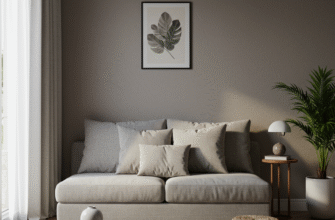Walking into your home should feel like a sigh of relief, a release from the pressures of the outside world. But often, the reality is quite different. Instead of peace, we’re greeted by piles of stuff – on counters, chairs, floors, shoved into drawers and closets. This physical clutter doesn’t just take up space; it takes up mental energy, contributing to stress, distraction, and a general feeling of being overwhelmed. Creating a peaceful living space often starts with the sometimes daunting, yet ultimately rewarding, process of decluttering. It’s about more than just tidying up; it’s about intentionally curating your environment to support a calmer, more focused life.
The journey begins not with tossing things out, but with a slight shift in perspective. Why do we hold onto so much? Often, it’s fear – fear of needing it later, fear of wasting money, or fear of letting go of memories attached to objects. Sometimes it’s simply inertia. Understanding these attachments is the first step. Instead of asking “Could I use this someday?”, try asking “Do I use this regularly? Does it serve a purpose in my life right now? Does it bring me joy or add value?”. Shifting the focus from potential future scarcity to present-day function and feeling can make letting go significantly easier.
Making a Start: Small Steps, Big Impact
The sheer volume of clutter can feel paralyzing. Looking at an entire room, or even a whole house, and thinking “I need to declutter all of this” is enough to make anyone want to retreat to the sofa. The secret? Don’t tackle it all at once. Break it down into laughably small chunks.
Start with one drawer. Just one. Empty it out, decide what truly belongs there, and put only those items back neatly. Or pick one shelf on a bookcase. Or the top of your nightstand. Completing a small area provides a quick win, a boost of motivation that makes tackling the next small area feel achievable. Consistency is far more powerful than intensity here. Fifteen minutes a day dedicated to decluttering will yield far better long-term results than one exhausting eight-hour marathon that leaves you burnt out and vowing never to declutter again.
Another simple trick is the ‘One Minute Rule’. If a task takes less than a minute to complete – like putting a dish in the dishwasher, hanging up a coat, or putting a piece of junk mail straight into the recycling – do it immediately. These tiny actions prevent small messes from accumulating into overwhelming clutter.
Strategies for Effective Decluttering
Once you’ve built some momentum with small starts, you can employ more structured strategies. Different methods work for different people and different types of clutter, so feel free to experiment.
The Four-Box Method
This is a classic for a reason. Get four boxes (or designate four areas) and label them:
- Keep: Items you use, love, and that definitely belong in this space. Be honest!
- Donate/Sell: Items in good condition that you no longer need but someone else could use.
- Trash/Recycle: Items that are broken, unusable, expired, or otherwise ready to be discarded responsibly.
- Relocate: Items that don’t belong in the area you’re currently working on but do have a place elsewhere in your home. Deal with this box promptly once you’re done with the current session to avoid just moving clutter around.
Work through your chosen small area, placing each item into one of the four boxes. Resist the urge to create a ‘Maybe’ pile – force a decision.
Tackling by Category
Instead of working room by room, you can choose to declutter by category across your entire home. For example, gather all your books from every room into one place. Seeing the sheer volume can be eye-opening and make it easier to decide which ones truly deserve shelf space. Other categories could include clothes, toiletries, office supplies, kitchen gadgets, or hobby materials. This method helps prevent keeping duplicates and ensures you’re assessing similar items against each other.
The Hanger Trick for Clothes
Closets are notorious clutter zones. A simple trick to identify clothes you don’t wear is the reverse hanger method. Hang all your clothes with the hangers facing backward. After you wear an item and wash it, hang it back up with the hanger facing the correct way. After a set period – say, six months or a year – you’ll have a clear visual indication of which clothes you haven’t reached for. This makes it much easier to part with unworn items.
Beware the “Someday/Just In Case” Trap. While it’s practical to keep genuinely useful backups, holding onto excessive ‘just in case’ items or things for a hypothetical ‘someday’ often creates more stress than security. If you haven’t needed it in a year and have no concrete plans for it, seriously question its place in your home. Letting go frees up not just physical space, but mental energy too.
Navigating Sentimental Clutter
This is often the hardest category. Items tied to precious memories or loved ones feel impossible to discard. It’s important to acknowledge these feelings and approach sentimental items with sensitivity, but also with the goal of curating, not hoarding. Ask yourself if the memory truly resides in the object itself, or in your heart and mind. Could you take a high-quality photograph of the item to remember it by? Could you keep just one or two representative pieces from a larger collection? Creating a dedicated, contained ‘memory box’ for treasured items can be a good compromise, allowing you to keep meaningful things without letting them clutter your daily living space.
Keeping Clutter at Bay: Building New Habits
Decluttering isn’t a one-off project; it’s the start of maintaining a more intentional relationship with your belongings and your space. To prevent the clutter from creeping back in, you need sustainable habits.
Implement the ‘One In, One Out’ Rule
This is particularly effective for categories like clothing, books, or decorative items. When you bring a new item into your home, make a commitment to let go of a similar item. Bought a new pair of shoes? Choose an old pair to donate. Received a new mug? Pass on one you don’t use often. This forces you to consciously evaluate purchases and prevents accumulation.
Schedule Regular, Quick Purges
Don’t wait until things get overwhelming again. Pencil in short decluttering sessions into your routine – maybe 10-15 minutes every weekend, or dedicate the last day of each month to a quick sweep for things that no longer belong. This regular maintenance keeps clutter manageable.
Practice Mindful Consumption
Before buying anything new, pause and ask: Do I truly need this? Do I already own something similar that serves the same purpose? Where will this item live in my home? Do I have space for it? Becoming a more conscious consumer is the most effective way to prevent clutter before it even starts.
Give Everything a Home
Clutter often accumulates because items lack a designated storage spot. When things have a clear ‘home’, it’s much easier to put them away immediately after use. Invest time in organizing your storage spaces (drawers, closets, cabinets) so that everything you decide to keep has a logical and accessible place. Labeling shelves or containers can also be incredibly helpful.
Embracing the Peace
A decluttered home offers more than just visual appeal. It reduces distractions, making it easier to focus on work, hobbies, or relaxation. It saves time and energy previously spent searching for lost items or constantly tidying surface clutter. Most importantly, it fosters a sense of calm and control. Your home becomes a sanctuary, a space that truly supports your well-being. Remember that decluttering is a personal journey, not a race or a competition. Progress, not perfection, is the goal. By implementing these tips and finding strategies that work for you, you can transform your living space from a source of stress into a haven of peace.








